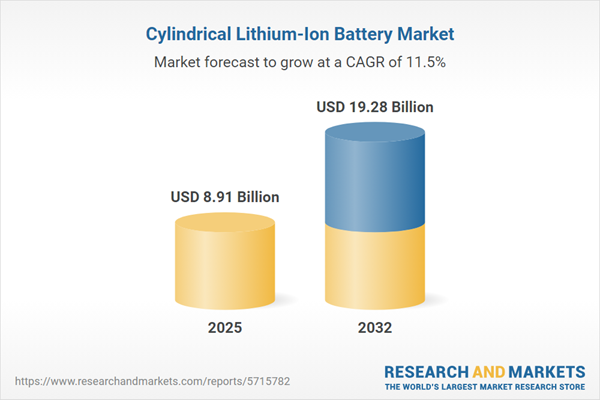Speak directly to the analyst to clarify any post sales queries you may have.
The cylindrical lithium-ion battery market is experiencing robust transformation, propelled by advancements in materials, diverse applications, and the need for reliable energy storage. This report delivers an executive-level overview, enabling senior leaders to identify opportunity corridors and make strategic decisions with clarity and confidence.
Market Snapshot: Cylindrical Lithium-Ion Battery Market Growth
The cylindrical lithium-ion battery market grew from USD 8.05 billion in 2024 to USD 8.91 billion in 2025. It is expected to continue growing at a CAGR of 11.53%, reaching USD 19.28 billion by 2032. This growth trajectory is driven by continual innovation and the expansion of end-use sectors, including transportation, grid storage, and healthcare. As demands for scalable, safe, and high-performing battery systems intensify, the market's strategic significance in the evolving energy storage ecosystem increases globally.
Scope & Segmentation
- Battery Types: Includes 18650, 21700, 26650, and 32560 formats, with newer designs enabling higher thermal management and energy density for automotive, grid storage, and compact applications.
- Battery Chemistries: Features lithium cobalt oxide for specific energy; lithium iron phosphate for longer cycle life and safety; lithium manganese oxide for rapid charging and use in portable and industrial tools.
- Battery Capacity: Ranges from below 1000 mAh to above 5000 mAh, aligning with the needs of wearable, medical, electric vehicle, and utility applications.
- Sales Channels: Encompasses offline retail for certified logistics and online sales platforms delivering variety and convenience to a global customer base.
- Applications: Covers automotive, consumer electronics, energy storage systems, medical devices, and portable lighting, each with distinct compliance and reliability demands.
- Regions: Analysis spans Americas, Europe, Middle East, Africa, and Asia Pacific, considering sub-regional dynamics and their roles in shaping supply and demand.
- Industry Players: Profiles 25 companies, highlighting strategies in vertical integration, capacity expansion, partnership building, and sustainability.
Key Takeaways: Strategic Insights for Decision-Makers
- Standardization of cylindrical lithium-ion battery formats has streamlined production, improved manufacturing scalability, and fostered compatibility in system design.
- Recent technological advances in electrode materials and automated production have enhanced battery safety, lifecycle, and charging efficiency while maintaining consistent quality at scale.
- Emerging end-use cases in electric vehicles, grid-level storage, and healthcare are driving differentiated performance requirements, leading to rapid adaptation of chemistries and cell sizes.
- Sustainability is becoming foundational, with manufacturers investing in closed-loop recycling, bio-based binders, and resource-efficient manufacturing to reduce environmental impact across the value chain.
- Regional ecosystems influence development: robust incentives in the Americas, decarbonization-driven policies in EMEA, and dynamic industrialization in Asia Pacific steer innovation and localization strategies.
- Strategic partnerships and alliances among material suppliers, research institutions, and cell integrators are enhancing resilience and accelerating time-to-market for next-generation solutions.
Tariff Impact: Navigating Regulatory Shifts in 2025
Recent United States tariffs on cell components and raw materials have introduced new cost structures and prompted a re-evaluation of sourcing and manufacturing approaches. The response includes shifting production to regional hubs, diversifying supplier networks, and forming alliances to ensure stable material flows and safeguard profit margins—trends that will likely continue as trade and policy environments evolve.
Methodology & Data Sources
This report’s findings are grounded in a rigorous mixed-methods approach combining expert interviews, technical analysis, and review of regulatory and peer-reviewed sources. Quantitative modeling is cross-checked against industry and proprietary databases, while qualitative patterns are systematically validated through peer review and methodological audits.
Why This Report Matters
- Enables executives to anticipate disruption and recognize actionable opportunities within the cylindrical lithium-ion battery sector.
- Supports strategic planning by delivering in-depth segmentation, regional trends, and competitive positioning insights for optimized investment decisions.
- Provides clarity on navigating regulatory, technological, and supply chain complexities relevant to long-term business growth.
Conclusion
The cylindrical lithium-ion battery market is evolving in response to new technologies, policies, and supply dynamics. Senior leaders equipped with this report’s insights will be better positioned to capitalize on growth prospects and navigate the market’s complex, opportunity-rich landscape.
Additional Product Information:
- Purchase of this report includes 1 year online access with quarterly updates.
- This report can be updated on request. Please contact our Customer Experience team using the Ask a Question widget on our website.
Table of Contents
3. Executive Summary
4. Market Overview
7. Cumulative Impact of Artificial Intelligence 2025
Companies Mentioned
The companies profiled in this Cylindrical Lithium-Ion Battery market report include:- Altertek Ltd.
- BorgWarner Inc.
- BYD Company Limited
- Dongguan CHAM Battery Technology Co., Ltd
- Duracell Inc.
- E-One Moli Energy Corporation
- EAS Batteries GmbH
- Enpower Greentech Inc.
- EVE Energy Co., Ltd.
- Hitachi Ltd.
- Jiangsu OptimumNano Energy Co., Ltd
- Jiangsu Tenpower Lithium Co., Ltd.
- LG Chem, Ltd.
- Murata Manufacturing Co., Ltd.
- Nanograf Corp.
- Padre Electronics Co.,Limited
- Panasonic Holding Corporation
- Samsung SDI Co., Ltd.
- Shenzhen BAK Battery Co., Ltd.
- Shenzhen XTAR Electronic Co., Ltd.
- Sony Corporation
- TADIRAN BATTERIES Ltd.
- TianJin Lishen Battery Joint-Stock CO.,LTD.
- Tianneng Battery Group Co., Ltd.
- Ultralife Corporation
Table Information
| Report Attribute | Details |
|---|---|
| No. of Pages | 192 |
| Published | November 2025 |
| Forecast Period | 2025 - 2032 |
| Estimated Market Value ( USD | $ 8.91 Billion |
| Forecasted Market Value ( USD | $ 19.28 Billion |
| Compound Annual Growth Rate | 11.5% |
| Regions Covered | Global |
| No. of Companies Mentioned | 26 |









